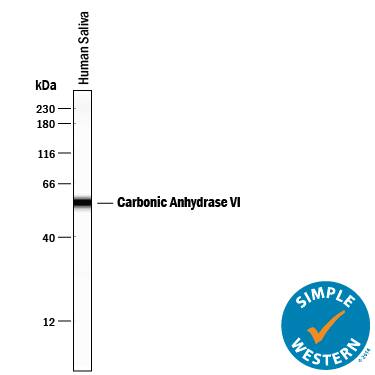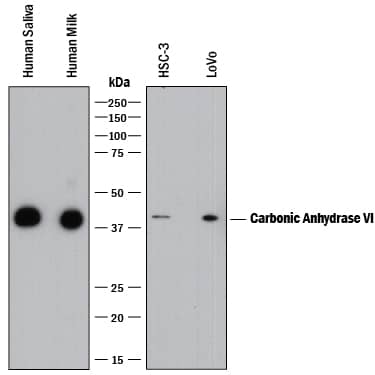Human Carbonic Anhydrase VI Antibody
R&D Systems, part of Bio-Techne | Catalog # AF2939

Key Product Details
Species Reactivity
Applications
Label
Antibody Source
Product Specifications
Immunogen
Gln18-Asn308
Accession # EAW71606
Specificity
Clonality
Host
Isotype
Scientific Data Images for Human Carbonic Anhydrase VI Antibody
Detection of Human Carbonic Anhydrase VI by Western Blot.
Western blot shows human saliva, human milk, and lysates of HSC-3 human oral squamous cell carcinoma cell line and LoVo human colorectal adenocarcinoma cell line. PVDF membrane was probed with 0.5 µg/mL of Goat Anti-Human Carbonic Anhydrase VI Antigen Affinity-purified Polyclonal Antibody (Catalog # AF2939) followed by HRP-conjugated Anti-Goat IgG Secondary Antibody (Catalog # HAF017). A specific band was detected for Carbonic Anhydrase VI at approximately 42 kDa (as indicated). This experiment was conducted under reducing conditions and using Immunoblot Buffer Group 1.Detection of Human Carbonic Anhydrase VI by Simple WesternTM.
Simple Western lane view shows lysates of human saliva, loaded at 0.2 mg/mL. A specific band was detected for Carbonic Anhydrase VI at approximately 56 kDa (as indicated) using 1 µg/mL of Goat Anti-Human Carbonic Anhydrase VI Antigen Affinity-purified Polyclonal Antibody (Catalog # AF2939) followed by 1:50 dilution of HRP-conjugated Anti-Goat IgG Secondary Antibody (Catalog # HAF109). This experiment was conducted under reducing conditions and using the 12-230 kDa separation system.Applications for Human Carbonic Anhydrase VI Antibody
Immunoprecipitation
Sample: Conditioned cell culture medium spiked with Recombinant Human Carbonic Anhydrase VI (Catalog # 2939-CA), see our available Western blot detection antibodies
Simple Western
Sample: Human saliva
Western Blot
Sample: Human saliva, human milk, HSC-3 human oral squamous cell carcinoma cell line, and LoVo human colorectal adenocarcinoma cell line
Formulation, Preparation, and Storage
Purification
Reconstitution
Formulation
Shipping
Stability & Storage
- 12 months from date of receipt, -20 to -70 °C as supplied.
- 1 month, 2 to 8 °C under sterile conditions after reconstitution.
- 6 months, -20 to -70 °C under sterile conditions after reconstitution.
Background: Carbonic Anhydrase VI
Carbonic Anhydrase catalyzes the reversible reaction of CO2 + H2O = HCO3- + H+, which is fundamental to many processes such as respiration, renal tubular acidification and bone resorption (1). Topics in a CA meeting (6th International Conference on the CAs, June 20‑25, 2003, Slovakia) ranged from the use of CAs as markers for tumor and hypoxia in the clinic, as a nutritional supplement in milk, and as a tool for CO2 removal and mosquito control in industry. Carbonic Anhydrase VI, also known as gustin and salivary Carbonic Anhydrase, is a zinc-metalloprotein that constitutes about 3% of human parotid saliva protein (2, 3). It was decreased in patients with loss of taste and pathological changes in taste buds (4). It is also an elementary component of milk. It plays an important role in normal growth and development of the infant alimentary tract (5).
References
- Hewett-Emmett, D. and R.E. Tashian (1996) Mol. Phylogenet. Evol. 5:50.
- Murakami, H. and Sly, W. S. (1987) J. Biol. Chem. 262:1382.
- Thatcher, B. J. et al. (1998) Biochem. Biophys. Res. Commun. 250:635.
- Hankin, R. I. et al. (1999) Am. J. Med. Sci. 318:380.
- Karhumaa, P. et al. (2001) Proc. Natl. Acad. Sci. USA. 98:11604.
Alternate Names
Gene Symbol
UniProt
Additional Carbonic Anhydrase VI Products
Product Documents for Human Carbonic Anhydrase VI Antibody
Product Specific Notices for Human Carbonic Anhydrase VI Antibody
For research use only

